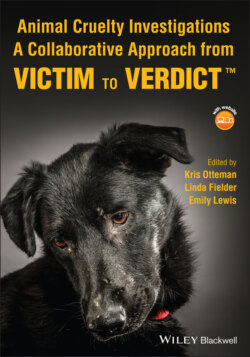Читать книгу Animal Cruelty Investigations - Группа авторов - Страница 131
3.4 Food and Water
ОглавлениеA good investigator always checks for food and water. However, as is the case with so many aspects of animal cruelty investigations, there are many factors at play to consider when assessing these two critical requirements.
Figure 3.3 Contaminated food and water pose health risks to animals.
Source: Oregon Humane Society.
Food and water must be of a quantity and quality that is beneficial to the animals. A canary who is fed only parrot food will not be able to break open the large seeds and gain adequate nutrition from his diet even though his bowl is always full. Likewise, if a horse has overgrown teeth that have not been maintained in some time, the horse will roll its hay or grass into a ball in its mouth repeatedly and eventually drop it. The horse's teeth lack the flat surface that allows it to grind the hay or grass into pieces it can swallow. A horse with this problem can starve to death in a pasture full of grass. A dozen cats may have access to a large hopper of dry food, but the group has established a hierarchy in which a percentage of older, weaker cats are denied access to the food by younger, more dominant ones. Water bowls and troughs may be full, but on closer inspection, there is no water service to the property, which could mean the animals are at the mercy of the rain to provide the water they need to sustain life.
Food and nutrition are areas where human ignorance often precedes animal suffering. The role of the veterinarian, animal control officers, and law enforcement in educating owners about proper nutrition should always come first when responding and identifying a problem. Many times, individuals take on pets or livestock without properly researching their care and feeding requirements.
